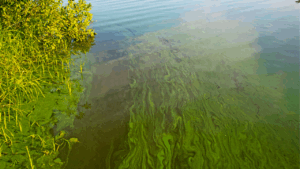by Paige Jessup, Climate Change Resiliency Intern
Cyanobacteria, also known as blue-green algae, is one of the oldest living organisms on earth and are generally unicellular. These organisms are photosynthetic and require sunlight, water, and nutrients such as nitrogen and phosphorus to reproduce. Due to current land use practices along Canada’s shorelines, humans are opening up these organisms to these perfect conditions they need to reproduce each year and also to reproduce earlier in the year.
Cyanobacteria are primary producers and are consumed by aquatic organisms, including zooplankton, aquatic insects, and fish, which in turn are consumed by larger aquatic animals and birds. Many types of Cyanobacteria produce cyanotoxins which are known to have effects on a wide range of aquatic organisms, including invertebrates and vertebrates (Ferrão-Filho et al., 2011). These range from acute effects like reduced survival and diminished swimming movements, to chronic effects like reduced ability to produce offspring which ultimately has impacts on population growth rate.

Cyanobacteria blooms depending on how severe, usually result in the lake becoming hypoxic, or “dead”. This happens for a few reasons: the blooms block out sunlight for other photosynthetic organisms like aquatic plants, and when the bacteria die off, decompose, and sink to the bottom of the lake, the decomposition process uses up all the oxygen needed for other organisms to survive (Harmful Algal Blooms (HABs) & Hypoxia, n.a.).
When a toxic form of Cyanobacteria gets into the groundwater or a significant body of water, it does not only affect the organisms in the lake, it also affects the terrestrial wildlife, human health and recreation, and the appearance of the lake. This is why it is important to keep excess nutrients out of our lakes by maintaining our septic systems, avoid using harmful pesticides, and maintaining natural shorelines. If you believe you have identified a blue-green algae bloom, or are unsure if you have spotted a bloom or non-toxic algae, be sure to report it to your local municipality, and avoid using, drinking, swimming, or bathing in the water and restrict pet and livestock access to the water.
This blog is part of a larger education toolkit about cyanobacteria. To access all of the resources from the toolkit, visit watersheds.ca/cyanobacteria
References
Ferrão-Filho, A. D. S., & Kozlowsky-Suzuki, B. (2011). Cyanotoxins: bioaccumulation and effects on aquatic animals. Marine drugs, 9(12), 2729–2772. doi:10.3390/md9122729
Harmful Algal Blooms (HABs) & Hypoxia. (n.d.). Cooperative Institute for Great Lakes Research. Retrieved from https://ciglr.seas.umich.edu/wp-content/uploads/2019/12/HABs-Hypoxia-Fact-Sheet.pdf
Nabout, J., Rocha, B., Carneiro, F., C.L, S.A. (2013). How many species of Cyanobacteria are there? Using a discovery curve to predict the species number. Biodiversity and Conservation. 22(12). doi:10.1007/s10531-013-0561-x
Zhang, W., Liu, J., Xiao, Y., Zhang, Y., Yu, Y., Zheng, Z., Liu, Y., & Li, Q. (2022). The Impact of Cyanobacteria Blooms on the Aquatic Environment and Human Health. Toxins, 14(10), 658. doi:10.3390/toxins14100658
This piece is part of an education toolkit generously funded by:

